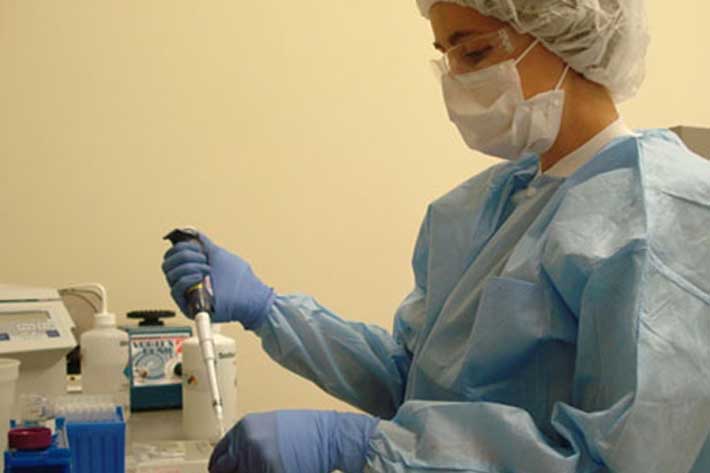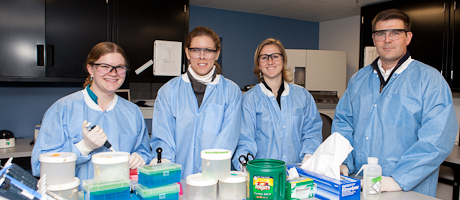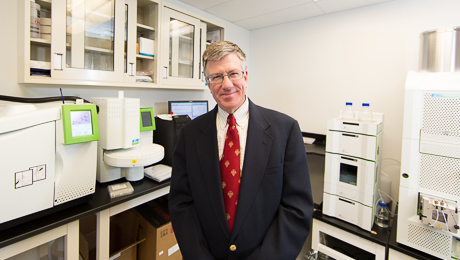By John DiConsiglio
When Adrienne Borges, M.S. ’06, arrives for work at the Bode Technology Group's Cellmark Forensics Lab in Lorton, Va., she dons her white coat and safety goggles and examines her workload.
It could be a drop of blood discovered at a D.C. crime scene or a brittle bone chip from a skeleton found in the Arizona desert. Maybe it is a single hair fiber recovered from the rubble of an earthquake in Peru.
Every tiny thread that lands on her lab table from tissue traces to jagged fingernails is a clue in solving a puzzle. By extracting and examining DNA from her samples, Ms. Borges, a veteran data analyst in Bode’s Human Identification Group, solves mysteries for international governments, police departments and families searching for lost loved ones.
Her analysis has helped to identify soldiers missing since World War II and to capture a Canadian serial killer, among other cases.
“What I love about this job is that I’m actually helping people,” she said. “I’m giving a voice to families who may have spent years looking for answers. I can bring them some peace of mind.”
As a forensic sciences student in the Columbian College of Arts and Sciences, Ms. Borges was drawn initially to the field’s technical aspects—the graduate program’s molecular biology track fit nicely with her undergraduate degree in biology. She quickly realized the field’s strong connection to real-world scenarios.
“Every student is aware of the responsibility they have as a forensic scientist. Their jobs will immediately impact society,” said Daniele Podini, assistant professor of forensic molecular biology and biological sciences. “Our students understand that what they are doing in the lab changes people’s lives. Not in the future, but right now.”
After graduation, Ms. Borges worked for the Armed Forces DNA Identification Laboratory, identifying the remains of unnamed soldiers. At Bode, she handles as many as 500 cases a year.
High-Tech Tools of the Trade
Although friends inevitably compare her to TV’s CSI heroes (“They have much better lighting than we do and wear better clothes,” she joked), Ms. Borges actually works with remarkably low-tech methods, along with cutting-edge technology. When examining a piece of bone, for example, Ms. Borges conducts what she calls a “laborious manual extraction process” that often involves slicing the sample and physically pulverizing it with steel blender cups. “You don’t see that on CSI,” she said.
The condition of the remains can make her job even trickier. Bones found in deserts may have decayed in the heat and sunlight. Old samples may be chalky and crumble. “You have to be very careful and follow strict protocols,” she said. When dealing with criminal cases that hinge on DNA evidence, “even the tiniest human error can cause big problems.” Take too small a sample and the results will suffer. Take too much and there may not be enough left for future examinations.
Ms. Borges’ lab also includes a high-tech sample-extracting robot and a state-of-the-art capillary electrophoresis machine that aids in yielding DNA profiles. Keeping abreast of the field’s fast-moving technology is critical for forensic analysts, a fact that Dr. Podini stresses in class.
“The technology changes so rapidly that students must always be learners,” he said. “I can teach them the technology they will use on their first case. But I have no idea what technology they will use on their last case before they retire. It probably hasn’t been invented yet.”
Indeed, Ms. Borges said field-savvy professors like Dr. Podini, who has a background in both law enforcement and professional forensic analysis, prepared her to instantly step into her career. “The GW teachers weren’t just academics. They were speaking from life experience,” Ms. Borges said. “They talked about the stresses they faced, the mistakes they made and what really goes on in the forensic world each day.”
Case Closed
For Ms. Borges, each day brings wins, losses and a staggering variety of cases. Her lab has helped identify people lost in conflicts and natural disasters around the world—from mass graves uncovered in Guatemala to victims of Hurricane Katrina, earthquakes and airline crashes. Recently, she worked with U.S. and Mexican authorities to examine skeletal remains found in Arizona deserts. Each year, hundreds of Mexican migrants die as they attempt to cross what is often desert terrain along the border into the United States. Comparing DNA from the scorched bones to samples from family members, Ms. Borges can often help resolve a missing relative’s fate. “We can’t bring back their loved ones, but maybe we can give them some closure,” she said.
Not every case has a satisfying ending. Ms. Borges is haunted by the unsolved story of a teenage girl who disappeared in 1958. Arizona police brought her a hair recovered from a shallow grave. While circumstantial evidence indicated it belonged to the missing girl, Ms. Borges was never able to establish a definitive link.
“That one sticks with me,” she said. “The family had waited so long for an answer. I couldn’t give it to them.”
But Ms. Borges has also scored incredible successes. Last year, she was part of an international team that DNA-tested the 70-year old bone fragments of Pvt. Lawrence Gordon, a missing World War II soldier. Mr. Gordon's family knew he'd been killed in 1944 during an Allied attack on a German stronghold in France. Of the 44 casualties in his division, 43 were identified and returned to their families. Gordon was the only one unaccounted for until Ms. Borges and her team helped positively identify his remains. He had been mistakenly buried as an unknown soldier in a German cemetery. Mr. Gordon's family was able to recover his remains and bury the soldier with his family in Canada.
“Each day can be like two sides of a coin,” Ms. Borges said. “Sometimes, things just don’t work out. Other times can be rewarding and remind you that every second in the lab affects a real life.”




